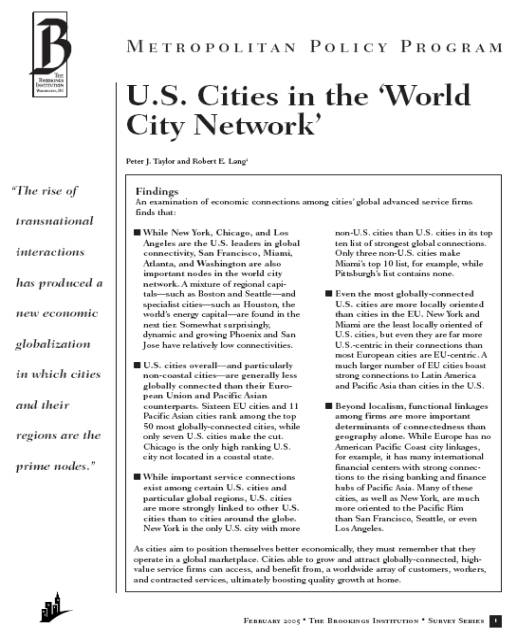Findings:
An examination of economic connections among cities' global advanced service firms finds that:
- While New York, Chicago, and Los Angeles are the U.S. leaders in global connectivity, San Francisco, Miami, Atlanta, and Washington are also important nodes in the world city network. A mixture of regional capitals—such as Boston and Seattle—and specialist cities—such as Houston, the world's energy capital—are found in the next tier. Somewhat surprisingly, dynamic and growing Phoenix and San Jose have relatively low connectivities.
- U.S. cities overall—and particularly non-coastal cities—are generally less globally connected than their European Union and Pacific Asian counterparts. Sixteen EU cities and 11 Pacific Asian cities rank among the top 50 most globally-connected cities, while only seven U.S. cities make the cut. Chicago is the only high ranking U.S. city not located in a coastal state.
- While important service connections exist among certain U.S. cities and particular global regions, U.S. cities are more strongly linked to other U.S. cities than to cities around the globe. New York is the only U.S. city with more non-U.S. cities than U.S. cities in its top ten list of strongest global connections. Only three non-U.S. cities make Miami's top 10 list, for example, while Pittsburgh's list contains none.
- Even the most globally-connected U.S. cities are more locally oriented than cities in the EU. New York and Miami are the least locally oriented of U.S. cities, but even they are far more U.S.-centric in their connections than most European cities are EU-centric. A much larger number of EU cities boast strong connections to Latin America and Pacific Asia than cities in the U.S.
- Beyond localism, functional linkages among firms are more important determinants of connectedness than geography alone. While Europe has no American Pacific Coast city linkages, for example, it has many international financial centers with strong connections to the rising banking and finance hubs of Pacific Asia. Many of these cities, as well as New York, are much more oriented to the Pacific Rim than San Francisco, Seattle, or even Los Angeles.
As cities aim to position themselves better economically, they must remember that they operate in a global marketplace. Cities able to grow and attract globally-connected, high-value service firms can access, and benefit from, a worldwide array of customers, workers, and contracted services, ultimately boosting quality growth at home.
Download:
[full report  (pdf)] (pdf)]
|
 |

